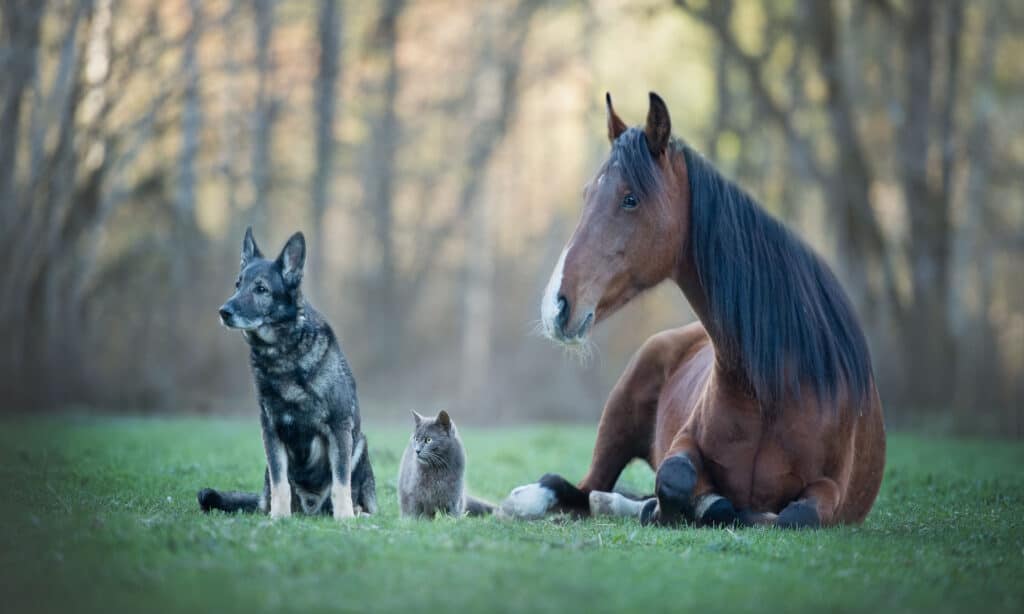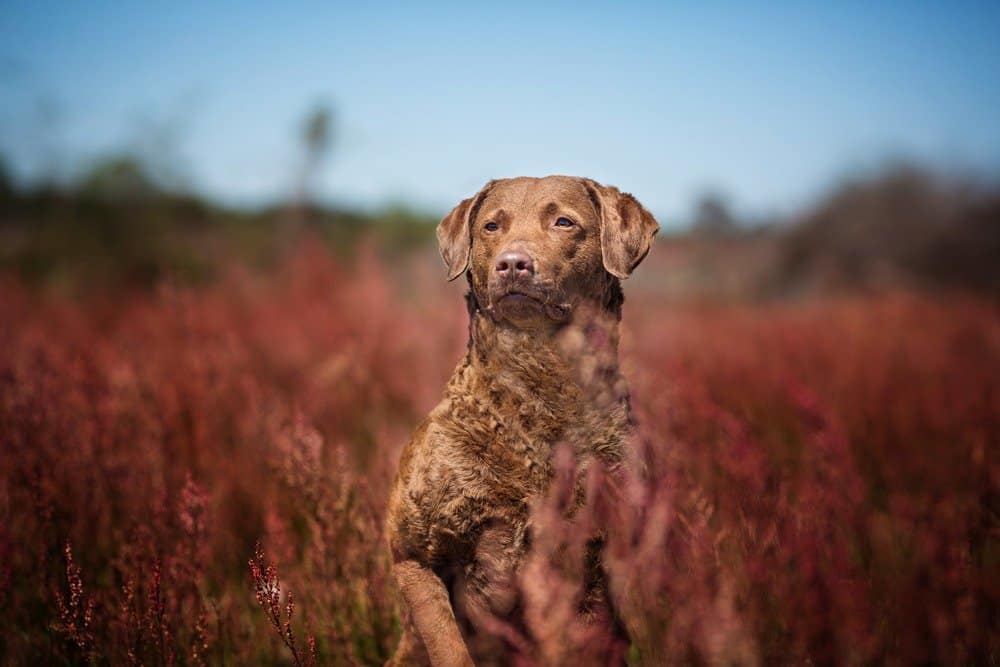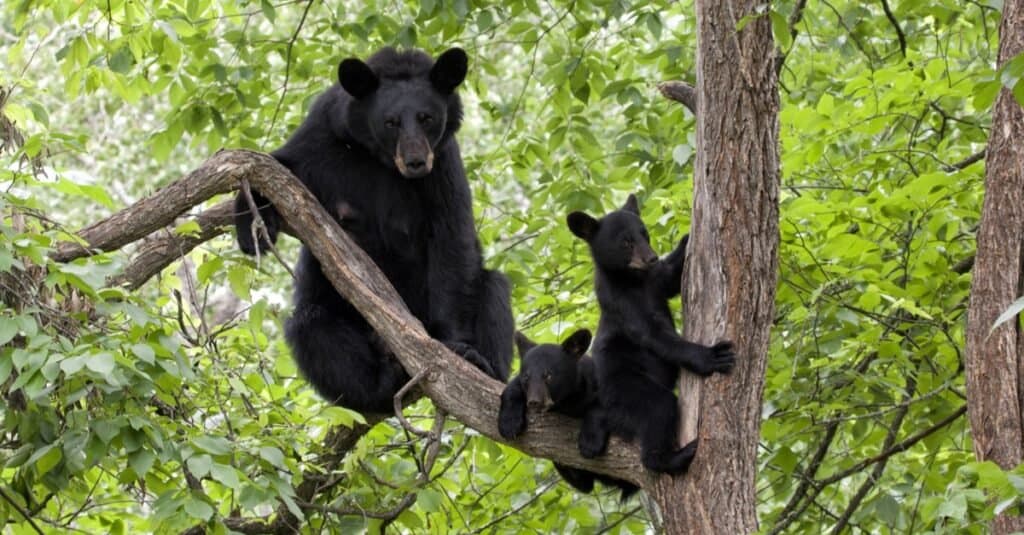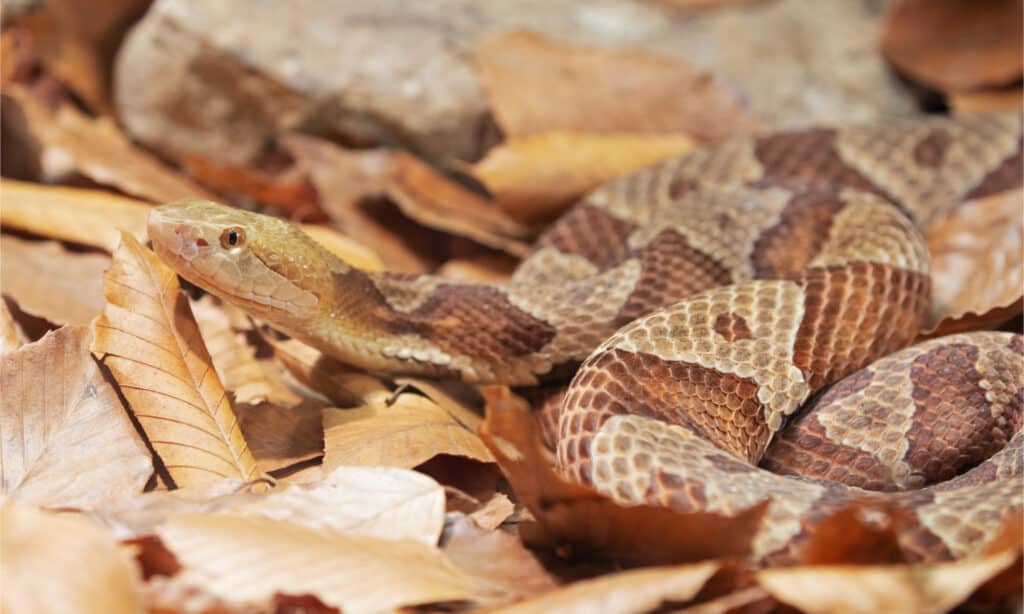While Maryland covers a small amount of area compared to other states, it stretches from the Appalachian foothills to the Chesapeake Bay Watershed, to the Atlantic Ocean. This is to say, this small state covers a tremendous amount of unique geography that contains thousands of animal species. Let’s dive into some of the most dangerous (and even deadly) animals in Maryland. Are there any poisonous or venomous animals in the state? What animals lurk in the Chesapeake Bay? We’ll find out all the etails below!
The state mammals of Maryland

The state mammals of maryland include a dog, a cat, and a
horse
.
©Enna8982/Shutterstock.com
A dog, a cat, and a horse. Those are the state mammals of Maryland, although it is a little more specific than that. The dog they chose was the Chesapeake Bay Retriever which is known to be an excellent hunting dog especially for retrieving from the Bay.
The cat that they chose as one of the state mammals is the calico cat and while this is not a separate breed it does describe a specific coloration that surprisingly only appears in females. And having a horse as one of your state animals makes sense when you are the host of the Preakness, a prestigious horse race that is held on the third Saturday in May in Baltimore. Maryland chose the thoroughbred horse as one of their state mammals. But are dogs, cats, and horses dangerous animals?
Are dogs, cats, and horses dangerous animals?

The Chesapeake Bay Retriever is one of Maryland’s state mammals.
©Kerrie T/Shutterstock.com
Cats can pass on diseases, horses can be dangerous to ride, and dogs are involved in way too many bites and attacks, especially with young children. Living with our common pets and farm animals can be dangerous, but if you follow a few basic guidelines it can help reduce the chances of accidents and injuries.
- Cats: In general, cats are very safe pets and loyal companions, but there are cases where they can carry disease so making sure your pet is up to date on its shots is very important. There were 2,383 reported cat bites in Maryland in 2019. The biggest threat from cats is Toxoplasmosis, which can be a serious disease, especially for pregnant women. The CDC recommends that pregnant women avoid changing kitty litter and also keeping your cat indoors during this time. In general, changing the cat litter box daily will help prevent this disease.
- Horses: Thoroughbred racing horses are well trained and rarely will throw a rider, but there are accidents when horses accidentally collide during a race. Some activists are concerned with the number of fatalities of racehorses due to injuries that the horses sustain. Horses on ranches and farms can cause injuries when ranchers are moving horses or caring for them, so it is important to follow all of the best practices of horse care.
- Dogs: Nationally, dog bites and attacks account for some of the highest number of injuries and fatalities. Far too often young children and babies are the victims of dog attacks. Keeping children supervised when around dogs is a key element in preventing senseless accidents. In Maryland there were 7,849 dog bites in 2019, that is an average of 21 bites a day! Dogs can be man’s (and families’) best friend but use precaution.
What “wild” animals are dangerous in Maryland?

Black bears live in four Maryland counties.
©Debbie Steinhausser/Shutterstock.com
Maryland was once home to gray wolves, mountain lions, and massive elks. However, today each of these species can no longer be found in the state. Today the largest predators are black bears and bobcats. Let’s dive into the history of black bears in the state.
- Black Bear: You would expect a black bear to be dangerous, just one look at a mouth full of sharp teeth and a glance at their long claws should make anyone nervous. Bears are big too, black bears are not as big as grizzly bears but they can still get to be 400+ pounds. Mother bears are very protective of their young and male bears can be aggressive during mating season. So anytime you see a bear you should keep your distance, authorities say at least 100 yards. The four counties in Maryland that have black bears are Garrett, Allegany, Washington, and Fredrick counties. Bear attacks are extremely rare, but there was one outside of Myersville, Maryland on Sept. 21, 2021. Renee Levow was out walking her dogs on a nearby trail when they ran into a bear. Encounters with bears that end up in attacks often have a similar story when dogs are involved. The dogs are off-leash and approach the bear, this irritates the bear and the bear chases the dog, the dog then retreats to its owner and brings the bear with it. Ms. Levow was bitten several times and was recovered in the hospital. Coexisting with bears can be tricky and people should get out and enjoy the beautiful forests of Maryland, but being aware of bear territory, keeping pets leashed, and carrying bear spray may decrease the chance of suffering from a bear attack.
What animals in the Chesapeake Bay are dangerous?

Chesapeak bay is home to sharks such as bull sharks during certain times of the year.
©Katja Tsvetkova/Shutterstock.com
One of the main features of Maryland is Chesapeake Bay, which stretches about 200 miles and is the largest estuary in the United States.
- Sharks: When you think about dangerous animals at the beach you probably think of sharks, but it is extremely rare to be attacked by a shark and even more rare to be killed by one. Since Maryland is on the bay it does not see a lot of sharks and the ones that do visit are typically the sandbar shark which are not dangerous to humans. That being said, there was an incident in Ocean City in August of 2021 where a 12-year-old girl was swimming and boogie-boarding and got bitten on her leg requiring 42 stitches. The culprit suspected was a sandbar shark. But when you look at the overall statistics of shark attacks and fatalities it is pretty rare. There are around 60 shark attarcks worldwide a year and only 30 per year on average in the US, and in Maryland it is next to never.
- Jellyfish: They look like harmless living jello-molds but they have stingers that can release painful venom into their victims. There are three kinds of jellyfish in the Bay, sea nettles, common jellyfish, and lion’s mane jellyfish. To avoid being stung you can wear a wet suit and also be aware of posted flags that may warn swimmers of jellyfish being present at certain times of the year. The stings of these species are painful but not fatal, so jellyfish are not the deadliest animals in Maryland.
What venomous animals live in Maryland?

Copperheads blend in extremely well with their surroundings.
©DnDavis/Shutterstock.com
Maryland is home to several venomous animals that can be dangerous. The black widow is Maryland’s only native spider that has venom which is a danger to humans. However, brown recluses have also been found in the state even though they’re not common. Of more concern are the two venomous snakes in the state which are the eastern copperhead and timber rattlesanke. We’ll explore both in more detail below.
Eastern copperheads and timber rattlesnakes: Two of the venomous snakes in Maryland are the copperhead which is a tan snake with dark hour-glass markings and the timber rattlesnake which is a big snake, they can get to be 3-5 feet long and are thick. They are tan with brown splotches on their backs. Both of these snakes are pit vipers and have fangs. They are venomous, with the timber snake being more venomous, but it is rare for them to be deadly. In the US, there are between 5,000-7,00 snake bites a year, but only an average of 5 people die from snake bites.
A list of dangerous animals in Maryland
The following animals in Maryland are dangerous and warrant your attention:
- Copperhead Snakes
- Timber Rattlesnakes
- Black Widows
- Bull Sharks
- Sand Tiger Sharks
- Sandbar Sharks
- Jellyfish
- Black Bears
- Ticks
- Domestic Pets (Dogs, Cats, etc.)
The photo featured at the top of this post is © Joe McDonald/Shutterstock.com
Thank you for reading! Have some feedback for us? Contact the AZ Animals editorial team.






